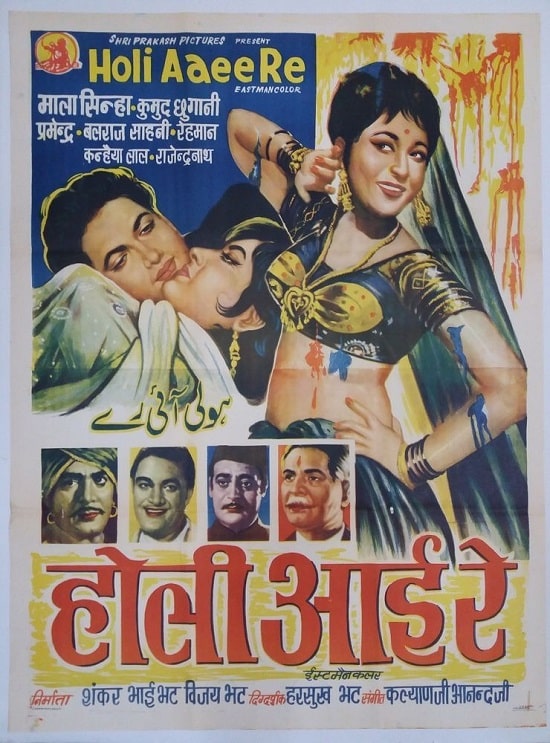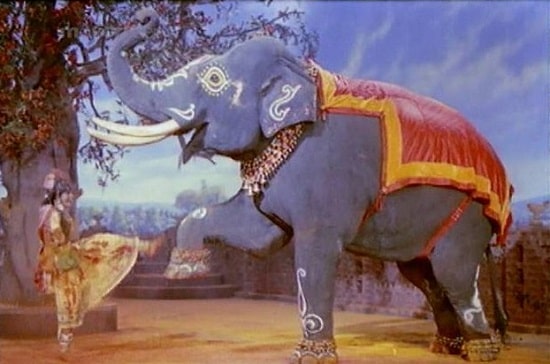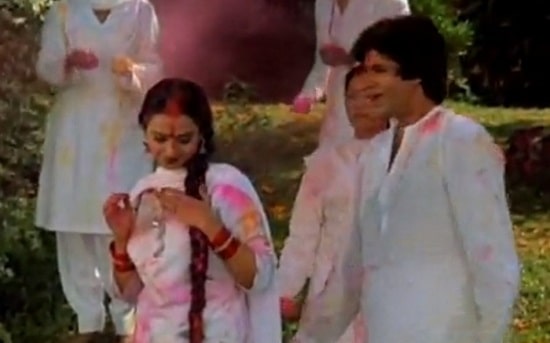Holi Aayi Re Kanhai… Rang Barse Bheege Chunar Wali ......by Bhim Raj
India is a land of ethnic festivals and the festival of colors “Holi” entwines in it the spirited elements of fun, joy, and happiness. Be it throwing colors at loved-ones, flinging balloons from balconies at some stranger on the street, Holi is all about tasting bitter-sweet life with a tinge of naughtiness.
To catch the essence and mood of Holi, numerous Bollywood films carry song-sequences especially before a catastrophe is going to occur. In ‘Sholay’, Gabbar Singh growling “Holi Kab Hai…” and the shot cuts to gulal & water-guns, the camera pans dancing belles. Veeru (Dharmendra) and Basanti (Hema Malini) rock the scene with an incredibly vibrant and energetic Holi song ‘Holi Ke Din..’. When we talk about Holi, instantly the most intense and iconic Holi song ‘Rang Barse Bheege Chunarwali..’ (Silsila) pops up in our mind.

This song has become an informal Holi hymn with the magic of the philanderer Amitabh’s baritone and Harivansh Rai’s lyrics. Amitabh and Rekha exhibited an element of Masti, unabashed flirting and the consequent embarrassment to the hapless spouses.
Holi is well steeped in our history and legends, the most popular being the legend of Bhakt Prahlada, who escaped unharmed while Holika got charred to death on the holy pyre. The other popular legend relates to Lord Krishna and his beloved Radha.
Holi is prominently celebrated in North India, Phagwa in Bihar, Dol Purnima in Bengal, and Hola Mahalla in Punjab. The ‘Lath Maar Holi’ of Barsana (UP), gives a rare opportunity to women to shoo away with sticks men singing provocative songs.
The lighting of bonfires, preparation of delicacies & sweets, consumption of Bhang, and a splash of colors, mark the festive celebrations in colorful merriment. The millions celebrate the rhythm of ecstasy and utter elation forgetting old grudges/ resentments.
Holi has caught the fancy of filmmakers since the early talkie era. Three films have been produced under the title ‘Holi’ apart from ‘Holi Aayi Re’(1970). Bollywood has captured the various moods and shades of Holi through a large number of songs created over the years.
The first Holi song ‘Hori Mujhe Khel Ko Tesu Manga De..’ featured in the movie Gulru Zarina (1932). Mehboob Khan’s Aurat(1940) had two Holi songs. Holi songs have been featured in many films like Jeevan Prabhat, Baghbaan, Baghi, Chingari, Aurat, Matwali Meera, Jogan, Aan, Rahi, Amrapali, Namak Haraam, Dhanwan, Nadiya Ke Paar, Mashaal, Aakhir Kyon, Kaamchor, Mangal Pandey, and Ranjhana, etc.
The Holi song, whether as a plot pivot or as a mood weaver, is a perennial in Hindi cinema. In the 1950-60 decades, the filmmakers sprinkled the screen with a splurge of color in films like Mother India, Kohinoor, and Navrang, etc. Since then, this cinematic tradition has smoothly segued without missing a vocoder beat.
Holi songs have seen a gradual but marked change in the style of music and picturization, from the mellow and richly classical Holi songs in the 50s to the fun songs in the 70s, the flirtatious songs of the 80s to the power-packed, rigorous dance sequences in the new millennium.
The epic ‘Mother India’ (1957) takes a drama break for the Holi festivities. The iconic song ‘Holi Aayi Re Kanhai..’ just overflows with romance and sass. The Holi village dance-off captures Radha (Nargis) and Shamu (Raaj Kumar) in their happier times before poverty engulfs them.
In the song ‘Are Ja Re Hat Natkhat..’ (Navrang), Sandhya, portrayed both avatars of Radha and Shyam in a fantasy world. This song is well-known even today for its stunning classical choreography. In Kohinoor's song ‘Tan Rang Lo Ji..’ tragedy king Dilip Kumar and tragedy queen Meena Kumari break away from their typical tragic roles. The colors flying in this fantastic celebration invite the entire kingdom for a Holi song-and-dance sequence.
In the unconventional Holi song ‘Holi Khelat Nandlal..’ (Godaan), no village belle is dancing around or facing the color/water-guns. The deepening relationship between the abandoned widow and the vagabond find expression in ‘Layi Hain Razaron Rang Holi..’ (Phool Aur Patthar).
The grand sets and water-guns opulence captured Waheeda's exuberance in ‘Ayee Holi Ayee..’ (Guide). ‘Holi Re Holi Rangon Ki..’ (Paraya Dhan), signify the “huddang” of Holi. Rajesh Khanna guzzles bhang and breaks into a rather thoughtful Holi number ‘Nadiya Se Dariya..’ (Namak Haraam).
Marked by the spirited catchphrase “Bura Na Mano, Holi Hai!”, white-sari-clad heroines frolicking around daintily and avoiding the overly-masculine hero, with the background dancers gyrating in sync, these songs ignite romance and showcase the mirth and excitement of this festival.
Kati Patang (1970) blended Holi fun with social reform as the coquettish Kaka zestfully sings ‘Aaj Na Chodenge..’ to shrinking violet Asha Parekh. Vijay Anand deftly created an atmosphere of riotous bonhomie in ‘Bhaagi Re Bhaagi..’ (Rajput). In ‘Deewana’, Holi is an occasion for Shah Rukh to express his impassioned love to the widowed Divya Bharti.

Many a myriad mood is reflected in the Holi songs. In a rather dark Holi song ‘Holi Aayi Re Mastano…’(Zakhmee), Sunil Dutt swears vengeance against those who have wronged him. In ‘Damini’ (1993), Meenakshi Seshadri is witness to the rape of her maid on Holi and she is the lone crusader for justice. The song ‘Mal De Gulal Mohe..’(Kaamchor) simultaneously evokes the moods of affinity and separation.
Souten's ‘Meri Pehle Hi Tang Thi Choli..’ revels in the bantering between lovers Rajesh Khanna and Tina.
From nerve-wracking twists to intense romance, there are many celluloid moments of celebrating Holi that shimmer and glitter. In Padmaavat, the Holi scene is divided between a very sensuous setting and a passionate display. The king of romance, Shah Rukh got just that extra bit flirty in ‘Soni Soni…’ ( Mohabbatein). Bollywood celebrated Holi, in a Gujarati way with the rocking number ‘Lahu Munh Lag Gaya..’ (Goliyon Ki Raasleela: RamLeela).
Deepika applies red-hot color on the neck and later lip-locks with Ranveer. This passionate scene redefines the spirit of on-screen Holi. In Waqt, the sizzling chemistry between Priyanka and Akshay amidst the haze of pink gulaal, undoubtedly made the song ‘Do me a favor let's play Holi..’ very, very hot.
‘Balam Pichkari..’ (Yeh Jawaani Hai Deewani), with rocking music, fast beats and hip breaking jigs has become the most favorite Holi song for the younger generation. This dreadfully catchy dance number, with impromptu fill-in-the-blank lyrics, depicts the fashion in which the urban populace play Holi with selfie sticks and garden hoses.
Darr(1993), focused on how Holi is used as an excuse to harass women. An obsessive stalker, Shah Rukh infiltrates Juhi Chawla’s Holi party to tell his “K-K-K-Kiran” how much he loves her. Under the exuberance and fun in ‘Ang Se Ang Lagana..’ fear lurks as the stalker camouflages and gets near to his prey.
The trend of star-studded Holi celebrations in Bollywood was initiated by showman Raj Kapoor at his studios. The invitee would first be greeted with a dip in the colored water pool. The festivities continued till late noon with people lost in the world of singing and dancing. After Raj's death, these celebrations lost significance.
The other famous B-town celebrities who come close to celebrating Holi extravagantly and sumptuously are Amitabh Bachchan and Subhash Ghai. Big B. still feels drenched in the success of his Holi songs ‘Rang Barse..’ (Silsila) and ‘Holi Khele Raghubeera..’(Baghban). Mouthwatering Holi delicacies, exotic drinks laced with bhang, songs, dance, and lot of fun mark the Holi there. Shabana Azmi and Javed Akhtar also throw Holi parties continuing a 40-year-long tradition initiated by Kaifi Azmi. Shah Rukh Khan and his wife Gauri used to host Holi parties for several years. Ekta Kapoor throws a lavish Holi party, where many TV and Bollywood stars enjoy the celebrations. But the pomp and grandeur that was there in RK Studio could not be replicated.

Holi has slowly been edged out of Hindi movies in the past decade. The colors of Holi have gradually faded from filmdom and the filmmakers have turned their attention to glamour instead. The peppy and trendy Holi songs are conspicuously absent from Bollywood. But Holi has been an effective ambiance for romance in Hindi Cinema, the naughty Holi songs will again splash color on the silver screen.
Greetings to all Let the colors flow and brighten up the canvases of your life.
Holi is a festival of colours. It is an inseparable part of Indian culture and, Bollywood never misses a chance to infuse the ‘Holi factor’ in the form of dance numbers with stars going footloose and crazy. The first song of Holi was from the 1931 film ‘Ghar Ki Laxmi’. The Mukhdaa of the song goes like – “Mo Pe Daar Gayo Saari Rang Rang Ki Gaagar, Kaisa Dhokha Diya. . .”. This and many other songs of that era are now lost.
When we talk about the songs of the 30s and 40s how can we forget the great K L Sehgal. He was an institution, with no parallel in the entire heritage of Hindi film music.Here I have taken a Non-film song of Sehgal on Holi. It was recorded in 1933.
In the 50s many Holi songs were picturised. Almost all the Top stars of that time wanted one Holi song in his or her film. Nargis sang a Holi song in the 1950 film Jogan, sung by young Geeta Dutt. In this Holi song, Geeta Dutt’s honey and sugar voice ooze masti in full measure. With music by Bulo C Rani, Jogan’s bhajans became the benchmark for decades to come.

India’s first technicolour film Aan exploited the colourful festival of Holi to fully utilize its highly expensive use of 16mm Gevacolour. Jai Tilak (Dilip Kumar) plays Holi with Mangala (Nimmi), a simple village girl. As he throws away her scarf in the melee, it mistakenly lands on the tempestuous and arrogant princess Rajshree (Nadira) who is touring the city on her royal elephant, making her assume something else!
With the advent of song and music in movies, the festivals of colours registered its presence with earliest Holi songs in the 1931 films like Daulat Ka Nasha (Kahe Mare Pikchari Lalla..), Paak Daaman (Na Maro Bhar Pichkari..) and ‘Ghar Ki Laxmi’(Moh Pe Daar Gayo Saari Rang Rang Ki Gaagar..).
-

-
Bhim Raj, Blogger
gbraj1950@gmail.com
Disclaimer : The opinions expressed within this article are the personal opinions of the writer/author. The facts and opinions appearing in the article do not reflect the views of Babushahi.com or Tirchhi Nazar Media. Babushahi.com or Tirchhi Nazar Media does not assume any responsibility or liability for the same.